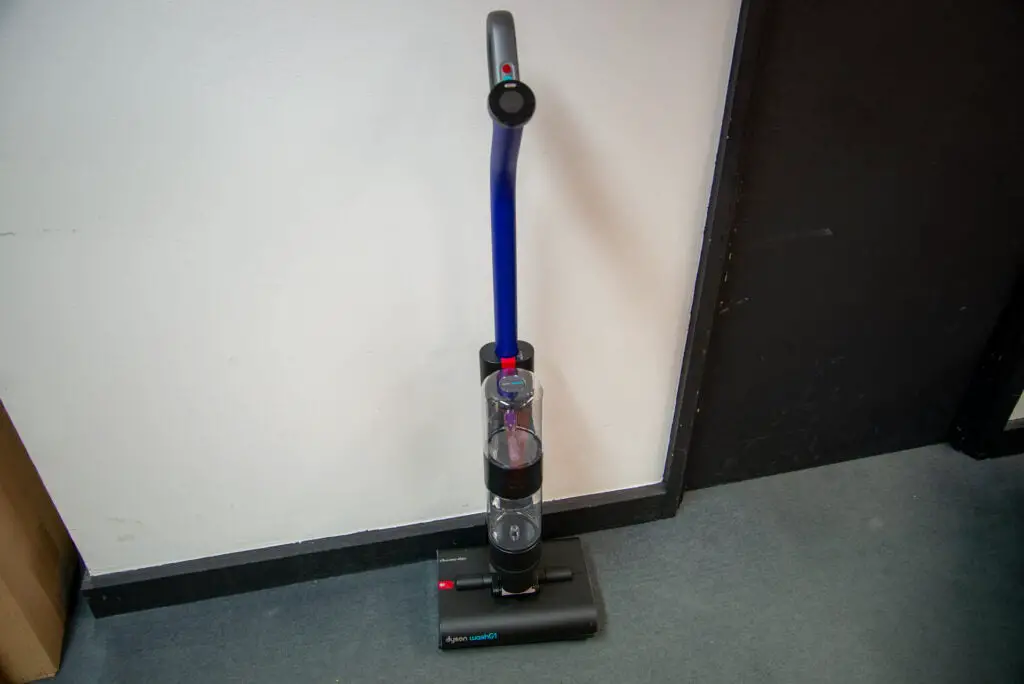Verdict
Brilliantly designed, the Dyson WashG1 uses a dual-roller system, which helps it glide effortlessly over the floor. It’s powerful, too, quickly removing even the toughest of stains, neatly separating solids from liquids for a fast clean-up at the end. It’s a touch heavy to lift onto a stand, the tanks aren’t well marked and it’s quite expensive, but if you want the best hard floor cleaner then this is it.
Pros
- Effortless to push around
- Cleans brilliantly
- Excellent separation of solids and liquids
Cons
- Expensive
- Tanks aren’t very well marked
Key Features
- TypeThis is a hard floor cleaner that doesn’t use suction, so is easier to clean out and doesn’t have any filters.
- Battery lifeRuns for up to 35-minutes on a single charge.
Introduction
It’s hard to believe, but the Dyson WashG1 is the company’s first full hard-floor cleaner, with the only other foray into the market the V15s Detect Submarine cordless vacuum cleaner that had a special attachment. The wait has been worth it, as the cleaner is easy to push around and powerful. It has a couple of slightly annoying design choices, but those aside this is a premium hard floor cleaner.
Design and features
- Uses dual mopping rollers
- Tanks aren’t clearly marked
- Nice LCD screen
The Dyson WashG1 is similar to other hard floor cleaners that I’ve reviewed, with a 1-litre clean water tank for dosing onto the rollers, and a 0.8-litre dirty tank for filth removed from your floor.
That roughly means that the dirty water tank has to be emptied every time the clean water tank is refilled, as some water can get left on the floor.
Rather than having a separate assembly for the clean and dirty tanks, they both unclip together, and then are removed separately. That’s quite neat, but it would have been nice if Dyson more clearly labelled which tank is which.
I found that the clear ‘Max’ line marked on the dirty tank often confused me and made me think it was the clean tank. The clean tank has a fainter fill line. It’s easier to go by colour: blue for fresh water, and red top for dirty water.
I’m a big fan of the tanks. They’re more like jars, with straight sides and big lids, so it’s easy to clean them out thoroughly, with no curves or edges to trap debris.
While the Dyson WashG1 is designed to be used with water alone, you can mix in detergent at the correct ratio if you prefer.
Dyson has designed the floor head differently from other cleaners, with dual rollers and dual brushes at the bottom. The rollers contra-rotate and are similar to those on the Dyson Omni-glide. Not only do they aid pick-up, but the way the rollers move makes the WashG1 glide across the floor, so it needs very little effort to manoeuvre. That’s not bad considering the unit weighs 4.9kg – a weight you only feel when having to carry the Dyson WashG1 up a flight of stairs or when putting it in its dock.
It helps that the angled handle has been designed in such a way that the Dyson WashG1 feels natural to hold. As the handle can go almost flat, the floor head can get under a lot of furniture, although the bulky tanks do get get in the way of some items, such as when trying to clean under a sofa.
Rather than using suction, the Dyson WashG1’s rollers are automatically dosed with water, and then they pick up solids and remove stains. Solids are deposited in a tray, removed by the dual brushes at the bottom, and dirty water is squeezed out of the rollers and filtered up into the dirty tank. That makes for easier clean-up, as the solids tray can slide out for easy cleaning, and the dirty tank just rinsed out.
The floor head has a marker that shows you where the best edge cleaning is, with the rollers reaching almost to the side of the unit. This is fine in most cases but get into a tight spot where the handle has to be lifted too high, and the power switches off. The handle has to go high before the power goes off, unlike with the GTech Orca, which is much more sensitive.
Via the LCD on top, there are three hydration modes to choose from, depending on how dirty the floor is, plus a Max button that you can hold down to add even more water to the floor. Each mode only changes the water flow, so battery life remains constant.
It’s nice to see a live battery life countdown on the screen, similar to the display on the company’s vacuum cleaners, such as the Dyson Gen5detect.
This screen can also be used for troubleshooting and information. For example, if you hit the power button with the handle in the upright position, the screen will show you that the handle needs to be angled backwards to start the rollers.
Once you’ve finished a clean and have emptied the solids tray and the dirty water tank, you can add fresh water, drop the Dyson WashG1 onto its charging dock and start the self-clean. This removes dirt from the rollers, and flushes out the system.
There’s no self-drying mode, so after the clean has finished you should remove the rollers and leave them to air-dry, as well as clean out the solids tray and tanks again.
Performance
- Excellent cleaning
- Brilliant edge performance
- Doesn’t handle hair well
I tested the Dyson WashG1 on a variety of dried-on stains. I started with a mud stain, which is a combination of trod-in dirt and fine particles. It only took a couple of passes over this to remove it.
I found that my dried on coffee stains were removed with ease, too. A simple swipe over the mess removed them and left my floor sparkling.
Moving on to my red wine stain, this was removed as easily as the cofee stains, with no trace of the mess left behind.
My tougher test is dried-on ketchup, which leaves a sticky mess behind. I found that I needed to resort to the Max mode and give the Dyson WashG1 several sweeps over the mess to pick up everything.
In Max mode, there was quite a bit of water left on the floor, so I had to give the G1 a chance to pick up this water after I’d cleaned, running it on a regular mode. At the end, all of the mess was gone.
I spread ketchup up to the edge of the kitchen unit and was impressed with the edge performance, with the WashG1 able to get much closer than other hard floor cleaners that I have reviewed.
Dyson says that the Dyson WashG1 is capable of dealing with solids, so I added ketchup and rice to the floor. I found that a couple of swipes was enough to pick up everything, with no solids spread.
At the end of the clean, the rice was all stored in the debris tray, which shows how impressive the separation of solids and liquids is.
I added human hair to the floor, and found that the Dyson WashG1 picked them all up with ease. However, I found that the hair was wrapped around the brushes inside, and I had to cut them out.
Based on this, if you live with pets or people with long hair, I’d vacuum the areas first with a dry vacuum and then mop with the Dyson WashG1. That also makes sense if there are a lot of other solids, as the tray is relatively small.
At the end of the clean, the dirty tank had filthy water in it but no solids, so it was really easy to clean out. I tapped the solids tray into the bin and washed it out, making clean-up easy.
Battery life is rated at 35-minutes, and I found that this was true. Overall, I found that a tank of water was enough to deep-clean my kitchen, before I had to refill. With the battery life on offer, I could clean the majority of floors in my house on a single charge.
When it came to sound, I measured the Dyson WashG1 at 70.8dB which is similar to a regular cordless vacuum cleaner.
Latest deals
Should you buy it?
You should buy it if you want powerful hard floor cleaning:
Simple to push around, the Dyson WashG1 glides around on its dual rollers and cleans tough stains fast.
You should not buy it want something cheaper:
This is expensive for a hard floor cleaner, so those on a tighter budget or with few hard floors to clean might want to look elsewhere.
Final Thoughts
It’s one of the more expensive hard floor cleaners, but the Dyson WashG1 is genuinely very impressive. It’s easy to push around and cleans brilliantly, with impressive separation of dirt and liquids. Better marked tanks would be nice, but that minor issue aside, this is an incredible hard floor cleaner. If you’re on a tighter budget, check out my guide to the best hard floor cleaners.
How we test
We test every hard floor cleaner we review thoroughly over an extended period of time. We use industry standard tests to compare features properly. We’ll always tell you what we find. We never, ever, accept money to review a product.
Find out more about how we test in our ethics policy.
Used as our main hard floor cleaner for the review period
Tested with real-world dirt in real-world situations for fair comparisons with other steam cleaners
You might like…
FAQs
How many modes does the Dyson WashG1 have?
There are three water levels to choose from plus an extra Max mode.
Is the Dyson WashG1 also a vacuum cleaner?
This cleaner doesn’t have a vacuum mode, but it can collect solids and deposit them in the tray at the bottom.
Trusted Reviews test data
Full specs
UK RRP
USA RRP
Manufacturer
Size (Dimensions)
Weight
Release Date
First Reviewed Date
Model Number
Provided heads
Bin capacity
Modes
Filters
Run time
Floor cleaner type
Detergent capacity
Dyson WashG1
£599.99
$999
Dyson
225 x 300 x 1140 MM
4.9 KG
2024
23/08/2024
Dyson WashG1
Floor head
0.8 litres
Three water levels plus Max
35 mins min
Hard floor cleaner
1 litres










